- Home
- What makes us unique?

- Customary
- The gaucho
- Mate
- Traditional festivities
- Tango
- Theater
- Gastronomy
- Music
- Soccer
- Carnival
- Film
- Murga
- Candombe
-
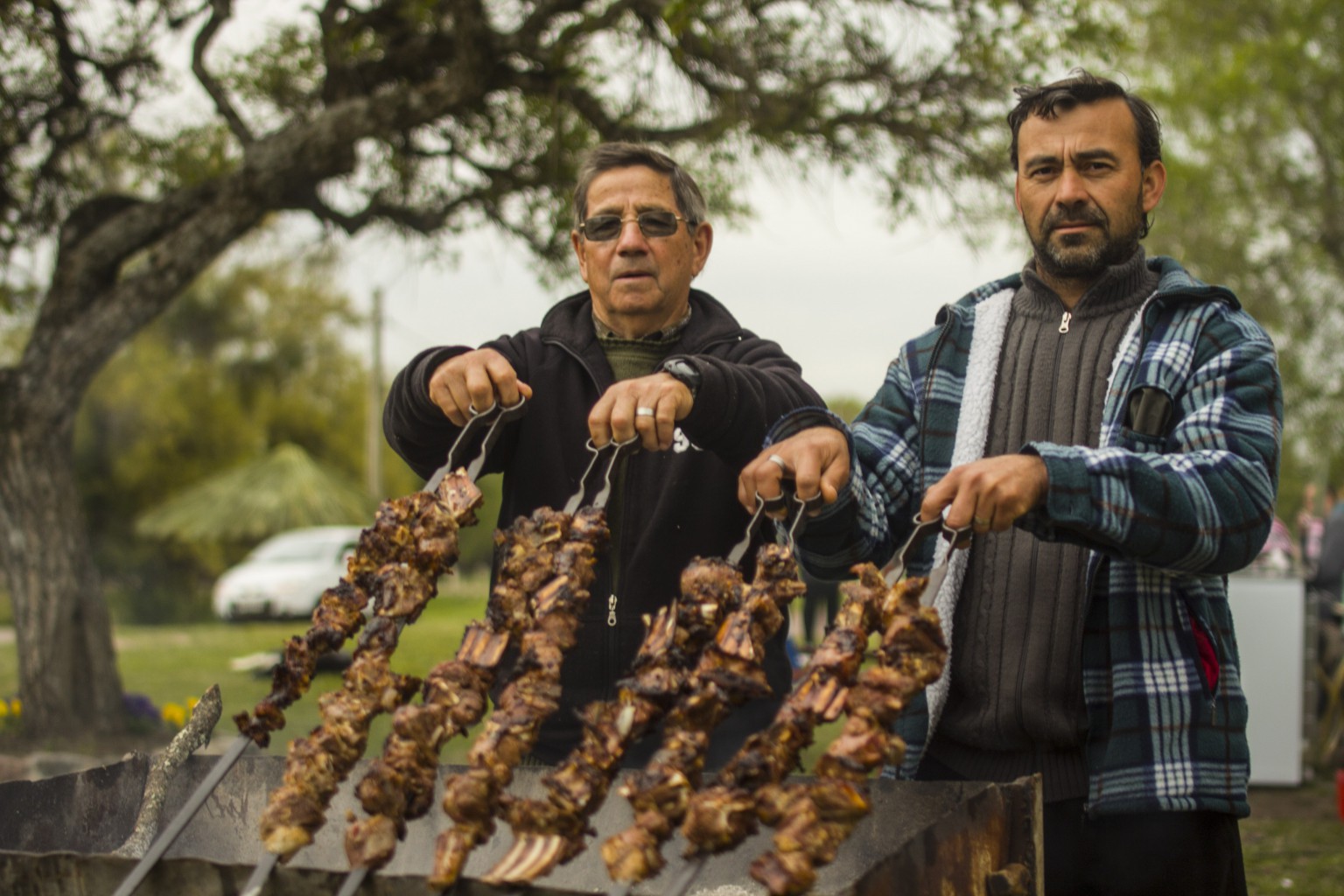
Customary
Mate, asado (barbecue) and soccer mark the daily rhythm of Uruguayans. Tourists will not be able to avoid some customs during their stay in the country.
Drinking mate
Mate is an infusion whose consumption is inherited from the Guarani Indians. It is not only in Uruguay that mate is drunk, although it is the country that proportionally more people drink it. Also Paraguay, Argentina, the south of Brazil and in some places in Chile and Bolivia.
Mate comes from the Quechua word “Mati”-calabaza- which is the container where the yerba is poured, whose scientific name is Illex paraguayensi. Yerba is stimulating due to the “mateina” component. At the same time, the high consumption of water has a purifying action, and its antioxidant action is beneficial for the organism. A bombilla is placed inside the yerba through which the infusion is sipped. The mate is the bearer of the most characteristic social symbolisms of this society, around it are woven complicities, confessions, friendship, and the sense of equals among those who share it.
Anthropologist Daniel Vidart maintains that “mate is a tradition that overcomes the isolationist customs of the criollo and evens out the social classes… and through the ages, it is the mate that made the wheel of friends, and not the wheel that brought the mate”. In the world, Uruguayans are easily recognized because wherever they go, they carry a thermos with hot water under their arm and the popular mate in their hand.
Going to the stage during carnival
In the past, in the neighborhoods, the “tablados” were set up in the streets -especially in Montevideo- once carnival arrived. It was a tradition for the neighbors to take their chairs from their houses to watch the different shows that the murgas, the parodists, the humorists or the comparsas could give. Today these neighborhood shows have been taken to large open spaces and have taken on a more professional character that is accompanied by a large audience.
Go for a barbecue
The asado not only fulfills a food function but also a gregarious function. “Getting together to eat an asadito” is a proposal of reunion, of friendship, of let’s have a good time. It is very common in Uruguay that every house has a barbecue grill and even buildings are designed with common areas that include it. Meat, the basic protein source of Uruguayans and the main source of foreign currency of our country, is also a fact of high social content.
Playing soccer
Soccer is the most popular sport in Uruguay. Two world championships and two Olympic championships of its national team, plus some continental and world achievements of its teams, made soccer live with an unusual intensity in our country. But the Uruguayan, being a public and a soccer fan, is above all a soccer player. Every child has played for children’s teams and every place, every open space is a place to “play ball”. What’s more, Uruguay is the only country in the world that has urban signage that tells vehicles to drive carefully because there may be children playing soccer in the street.
Camping during tourism week
Since the separation of the state and the church, Semana Santa has acquired at least two other names: Semana de Turismo (Tourism Week) and Semana Criolla (Creole Week). The Tourism Week corresponds to a camping tradition that alternates fishing and often controlled hunting with vacations in the interior of the country, especially in the hot springs of the Uruguayan coast. This tradition attracts all ages.
At the same time, the Creole week, gives the name to the activities and entertainments traditionally linked to the countryside that are taken to the city. The taming of colts is the show par excellence accompanied by folklore festivals. Beyond the many activities that take place all over the country, one of its greatest expressions is in the Montevideo neighborhood of El Prado, in the grounds of the Rural Association.
Camping during tourism week
Who knows why the rain is linked to the fried cake. It is probable that, in the country tradition, the impossibility of carrying out the tasks outdoors on rainy days, led them to the kitchen and once there to the simplest thing: to mix flour, fat, warm water and salt. Knead and fry. Try it next rainy day.
-

The gaucho
Today, the descendants of the original archetype, peons, foremen and farm and ranch foremen, troperos or reseros, tamadores and peasant singers, treasure the most endearing values of the gaucho: courage, country skills, horseback riding, frank hospitality and haughty gentleness.
The figure
In Uruguay, the gaucho is an important figure in national folklore as he symbolizes freedom and individuality. Poetic representations of the gaucho describe him as the ideal of bravery and independence. But beyond how he is presented in music, literature, and painting, this character constitutes an important symbol within Uruguayan culture.
He is the country man who works mainly herding cattle. In his stereotypical image, he is always accompanied by a horse, which, in addition to serving as a means of transportation, is one of the few material possessions associated with the gaucho way of life.
-
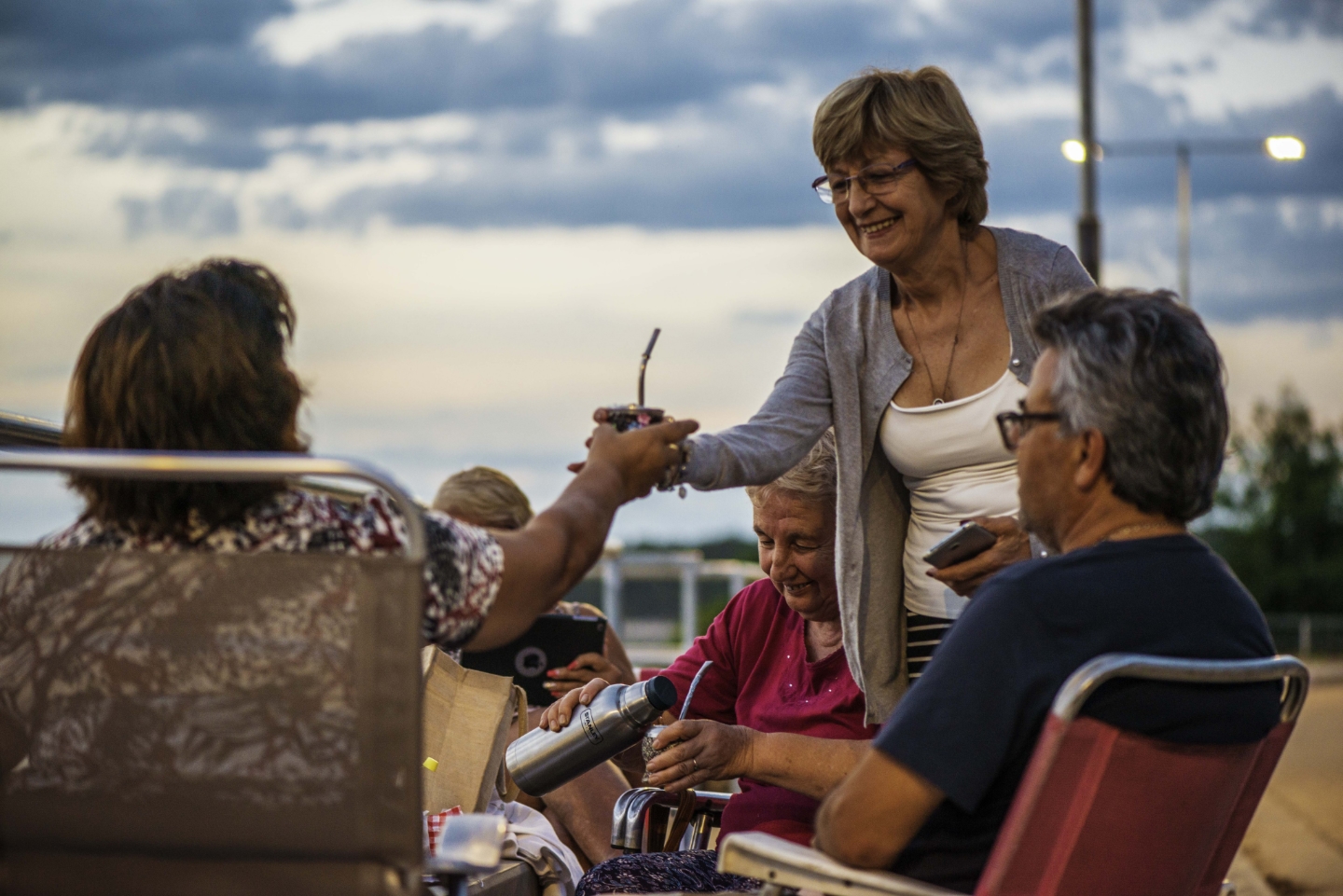
Mate
Mate is an inseparable companion of Uruguayans and a warm welcoming gesture for newcomers. The yerba mate infusion is stimulating.
Mate is a drink resulting from the infusion of “yerba mate” (dehydrated and ground leaves of Illex paraguayensis) and is one of the most typical and traditional cultural elements of Uruguayan society.
The custom of using the “thermos” and the abandonment of the “caldera” to prepare the infusion, is an Uruguayan initiative that freed the mate out of the home. This way and at present, mate is drunk in the most diverse public spaces, a fact that characterizes one of the most typical and daily images of our society.
Surely, if you have ever met a Uruguayan outside these borders, you have seen him or her accompanied by his or her “thermos and mate”, inseparable companions, regardless of the time of the year.
History
The origin of this drink dates back to pre-Hispanic times of the Guarani culture, but since the 17th century, while in Europe the custom of drinking tea was imposed, here in South America and specifically in Uruguay, the habit of drinking mate spread. Initially, mate became an inseparable companion of the country man.
Cimarrón, bitter, green, it was his faithful friend in his journeys through the fields, in moments of loneliness and also in moments of joy. With the passing of the years it conquered its place in the city, and today drinking mate is a common practice throughout Uruguay, as well as in Argentina, Paraguay and southern Brazil.
Usage
Depending on the place, the moment, or with whom you drink mate, it acquires different meanings. It can be a food, or just the companion of idle hours. It accompanies students, groups of friends, family, co-workers. It is an element of communion and the symbol of welcome for those who are greeted with a “mate calentito” at the door of the house.
The mate is generally drunk in a shared manner, and the same container and the same bombilla are always used, passing it from one person to another. This fact is what distinguishes it notably from the way in which other infusions, such as tea or coffee, are shared.
Properties
Yerba mate has substances of high nutritional value, such as vitamin A. The particular composition of yerba mate, especially its caffeine content, makes the infusion a very stimulating and tonic drink. It also acts as a diuretic and vasodilator.
-
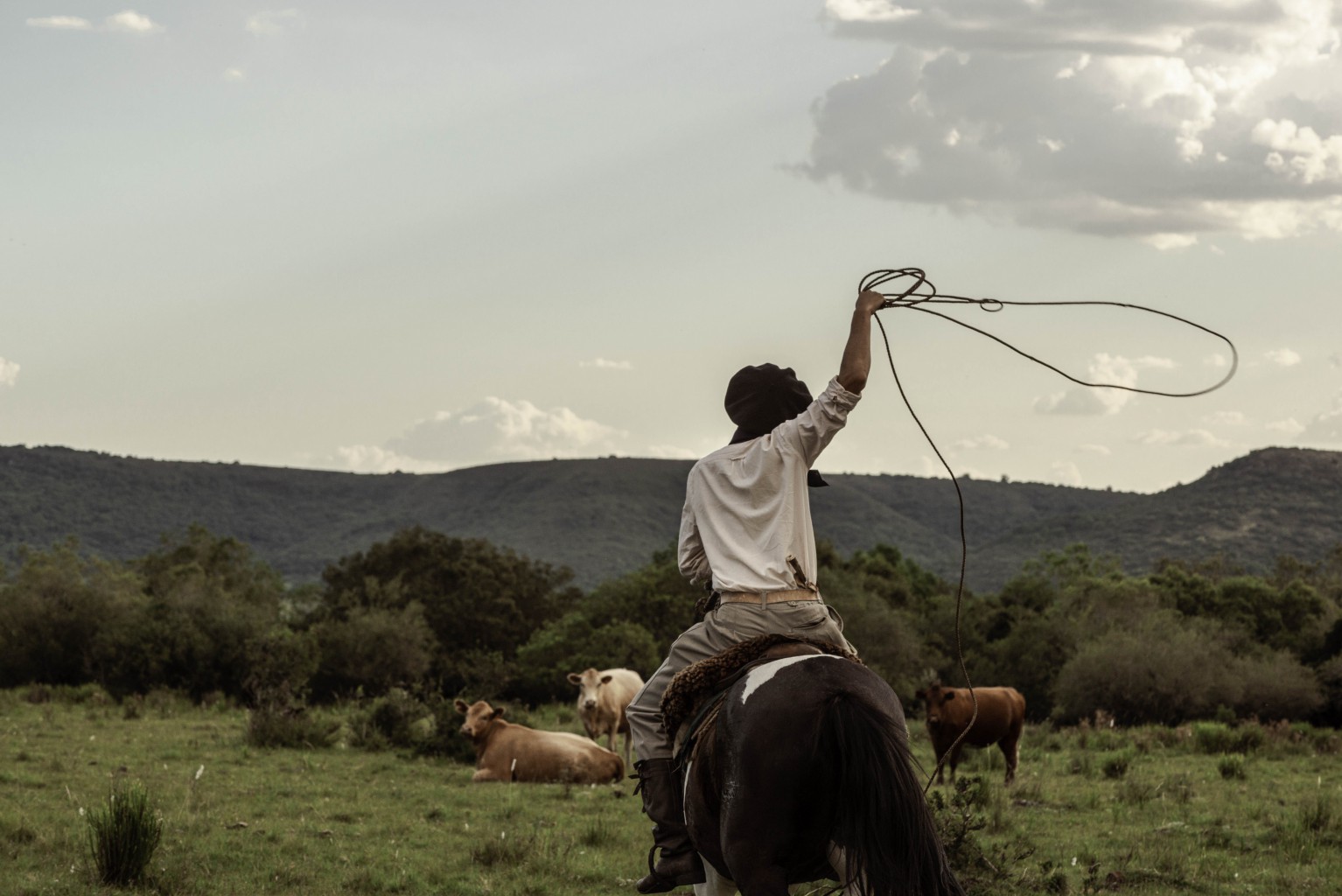
Traditional festivities
Singing, payadas, jineteadas, bonfires and country skills are protagonists in hundreds of traditional festivities throughout the year. We invite you to discover them.
Singing, “payadas”, “jineteadas”, “fogones” and “destrezas camperas” are protagonists in hundreds of traditional festivities throughout the year. We invite you to discover them.
The most representative rural traditions of the country are expressed through different parties and festivals held throughout the year throughout the Uruguayan territory. A clear example of this is the Fiesta de la Patria Gaucha in Tacuarembó, the Semana Criolla del Prado in Montevideo and the Parque Roosevelt in Canelones, among many others. Song, music, payadas, jineteadas, bonfires, demonstrations of country skills usually converge in these festivities that constitute a typical mark of the Uruguayan identity that cannot be missed.
Uruguayan folklore presents different manifestations and rhythms such as the Vidalita, the Milonga, the Payada and the Pericón, always accompanied by the guitar. This musical instrument, introduced during the period of Spanish domination, is inseparable from every Creole songbook and gaucho expression. In the same way, the accordion has enriched with its graceful cadence, the music of our folklore. -
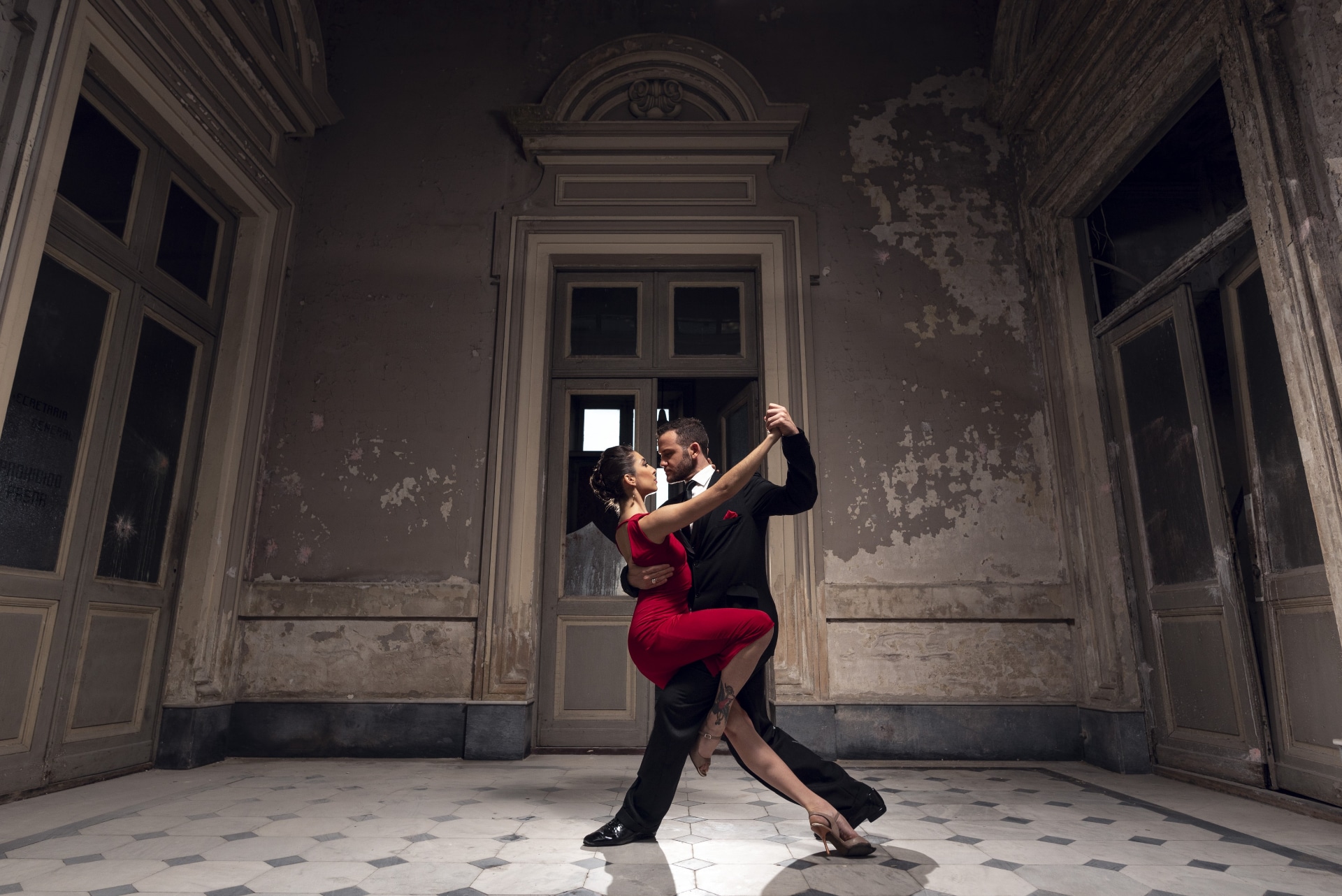
Tango
Tango is one of the most genuine and original cultural expressions of the Río de la Plata. Born from the fusion of musical traditions of African origin and European and Creole rhythms and instruments, it is a faithful witness of the cultural history of the region.
Tango is one of the most genuine and original cultural expressions of the Río de la Plata. Born from the fusion of musical traditions of African origin and European and Creole rhythms and instruments, it is a faithful witness of the cultural history of the region.
The gestation of tango took place in both Buenos Aires and Montevideo. A tangible example is the work “La Morocha” composed in Buenos Aires in 1905 by the Uruguayan Enrique Saborido, and “Mi Noche Triste”, written in Montevideo by the Argentine Pascual Contursi in 1916.
Tango was declared Intangible Cultural Heritage of Humanity by UNESCO in September 2009.
This music, which emerged at the end of the 19th century in the slums of Montevideo and Buenos Aires, has come a long way. Today tango is danced all over the world and international competitions are held. When we talk about tango we refer at the same time to the dance, the song and the musical genre itself. It is therefore a purely urban expression and one of the most genuine and original cultural manifestations of the Río de la Plata.
The dance
Tango was born as a popular dance with musical accompaniment. Later, music and lyrics became its protagonists, but this did not mean the abandonment of the original choreography of its dance, basically made up of the embrace of the couple with very sensual and complex steps.
Lirycs
From the appearance of the orchestra, lyrics or tango as a song began to have a remarkable boom, with creations of high poetic value, especially those written in the 1940s. As for the style, we could group the lyrics into comic, dramatic, humorous or lyrical. The songs speak of love feelings, peasant, urban, social, satirical and even philosophical themes.
The great diversity of the language used in the songs shows the influence of different cultural traditions and also a cultural phenomenon coming from low strata that gradually captivated enthusiasts of all social classes.
Music
In its beginnings, tango music was performed only with flute, guitar and violin. With the passage of time and the consolidation of the genre, the “sextet” or “typical orchestra” will appear to become the classic form of tango interpretation. The “sextet” is composed of piano, two bandoneons, two violins and double bass.
The orchestra can also consist of more instruments. The introduction of the bandoneon did not take place until the beginning of the 20th century, but it became an essential element.
Neither Uruguayan nor Argentinean: Rioplatense
In fact, tango is an authentically rioplatense product and son of miscegenation. Both countries, Uruguay and Argentina, which in the second half of the 19th century, when we were separated by only a few tens of years of having been part of the same viceroyalty, received more immigration than the number of inhabitants born in the place. Tango is an authentic result of this situation on both banks of the Río de la Plata. And as such, it was submitted by both countries to the Intangible Heritage of Humanity List, and confirmed by Unesco in 2009.
Sensual and urban
The tango is typically urban and the way of dancing it is recognized all over the world for its sensuality. The internationalization of the tango, which in principle was the result of the travels of Rioplatense musicians around the world, installed variants of tango in different countries of the world, as is the case of Finland, which contributed its own version with a form of tango with minor tones and where Seinajöki is considered the third city of tango after Montevideo and Buenos Aires.
“La Cumparsita”: from Uruguay to the world
This tango, which has been the soundtrack of countless films, was first performed on a street corner in Montevideo by Gerardo Mattos Rodríguez. Undoubtedly, it is the most known and interpreted tango in the world. But Uruguay has registered 17,000 tangos and has produced hundreds of poets, musicians and dancers who have written, created and performed on both sides of the Río de la Plata pieces that have traveled the world.
-
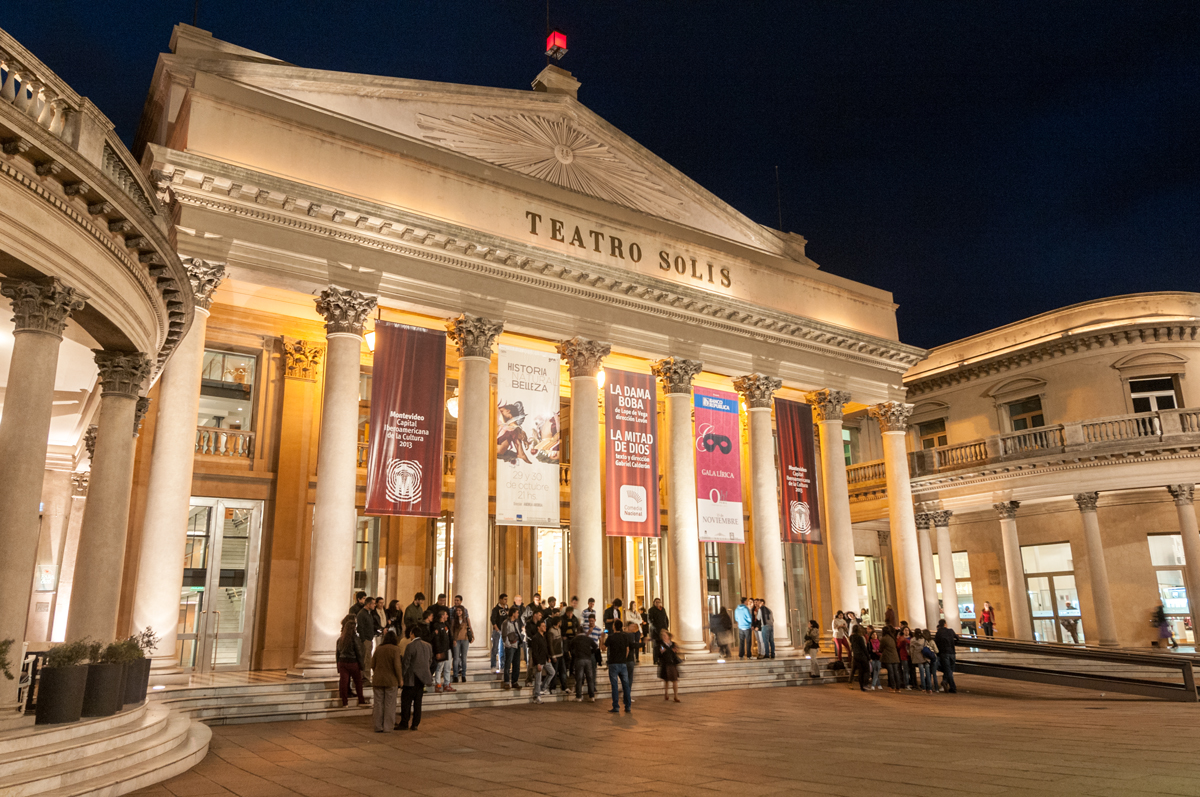
Theater
Uruguayan theater is one of the most important in Latin America. With more than 70 operating theaters, the billboard is strikingly extensive and varied with classic and modern shows for the most diverse tastes.
The Solís Theater, inaugurated in 1856, modernized in 1998 and reopened in 2005, is one of the emblematic buildings of the city of Montevideo and, particularly, of the Ciudad Vieja (Old City). As for the strictly theatrical activity, it is the scene of the most multitudinous representations of the National Comedy, dependent on the Departmental Intendancy of Montevideo.
The creation of the Comedia was a step forward in the professionalization of the Uruguayan theater at the time that it was looked for to create a space of programming to the national authors.
The Comedia Nacional presented its first show on October 2, 1947, “El león ciego” (The Blind Lion) by Uruguayan Ernesto Herrera. In 1949, the relevant Catalan actress Margarita Xirgu was appointed artistic director and director of the Municipal School of Dramatic Art. Xirgu’s direction imposed a very particular way of expressing classical theater.
Beyond the prestige of the Comedia Nacional, Uruguayan theater has been nurtured during the 20th century by a vigorous and fermenting independent theater that continues to be a cultural, creative and social pulley of Uruguayan and universal interests.
The Federación Uruguaya de Teatros Independientes (FUTI), is an entity that brings together some twenty theatrical groups from Montevideo characterized by their commitment to artistic activity and the social problems of the country’s inhabitants. Among the institutions with the longest trajectory we refer to: Teatro Italia Fausta (Teatro Anglo Cultural Complex), Teatro La Gaviota (Teatro Stella, Mercedes and Tristán Narvaja), Institución Teatral El Galpón (18 de Julio 1618), Teatro La Candela (Punta Carretas Shopping entrance), Espacio Teatro (Mercedes 865), Teatro Victoria (Río Negro 1479).
The Asociación de Teatros del Interior (ATI) concentrates the main groups of the interior of the country.
Solís Theater Stalls

Solis Stage

Solis Facade

Solís Luminaire
-
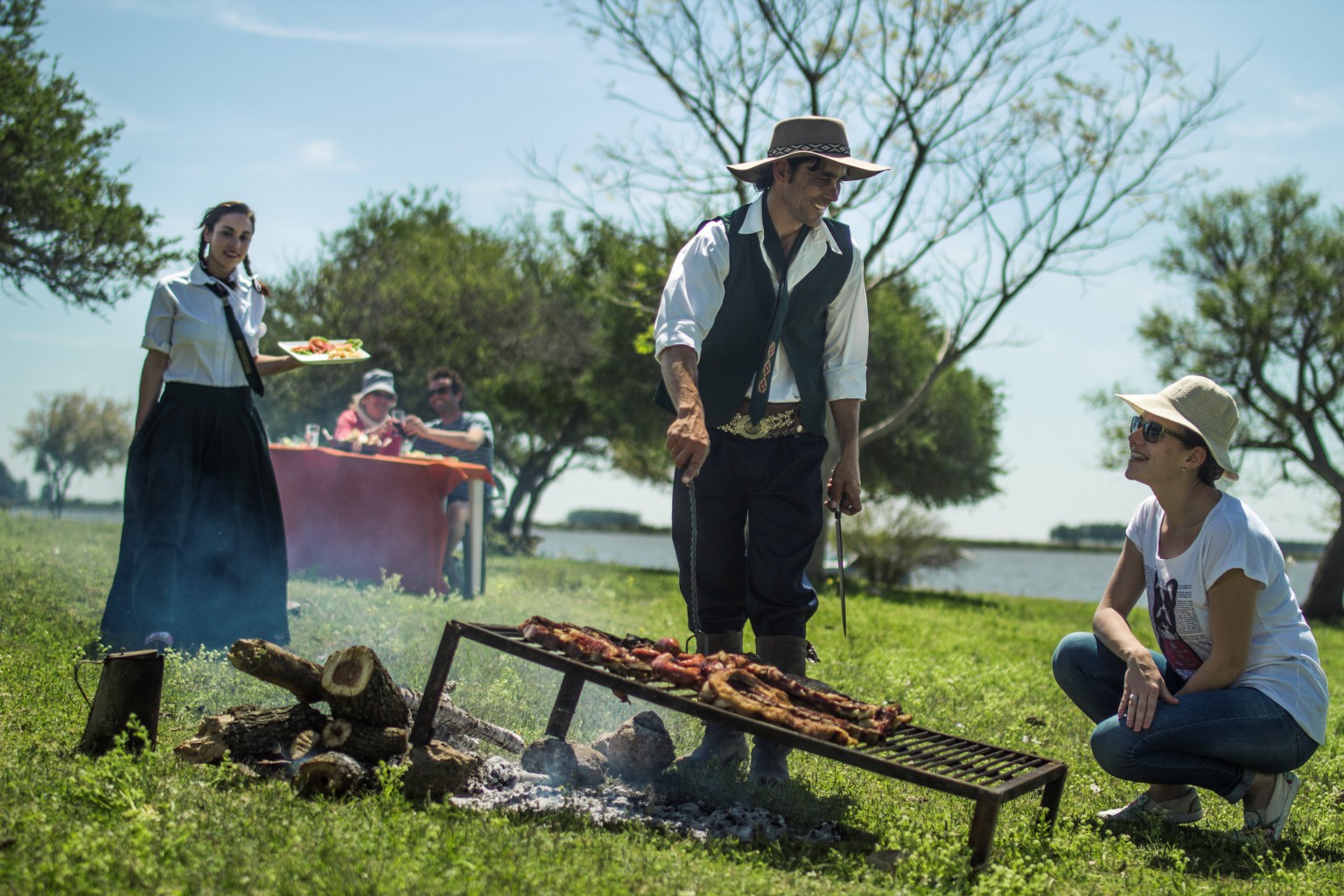
Gastronomy
The grill is par excellence one of the most outstanding menus of the Uruguayan diet. Tasting it with a glass of Tannat wine is an unmissable experience.
The grill is par excellence one of the most outstanding menus of the Uruguayan diet. Tasting it with a glass of Tannat wine is an unmissable experience.
With international recognition, the grill is par excellence one of the most outstanding menus of the Uruguayan diet. It consists of different types of meat grilled on the “parrilla”, a device built in iron and used for that purpose. The secret of this ancient cooking method is that it makes it possible to concentrate the juices of the food and thus preserve their own characteristic flavors.
Uruguayan wines are ideal to accompany these exquisite meats. Among those with an outstanding international positioning, those made from the Tannat grape variety stand out, defined as intense, powerful, serious and austere. This grape variety, originally from the southwest of France, was introduced in the mid-19th century, and its cultivation was so successful that Uruguay has become the world’s largest producer of this variety.
The dairy industry is highly developed in the country, with products of excellent quality, standing out a valued delicacy: dulce de leche. This sweet, highly appreciated by both children and adults, is used in a wide variety of desserts and other delicacies for the palate, which makes it the undisputed protagonist of Uruguayan confectionery. The foreigner who has had the opportunity to taste it will surely never forget its exquisite flavor, its creamy consistency, its brightness and characteristic color that make it unique in the world, making it very different from its similar ones produced in other countries.
-
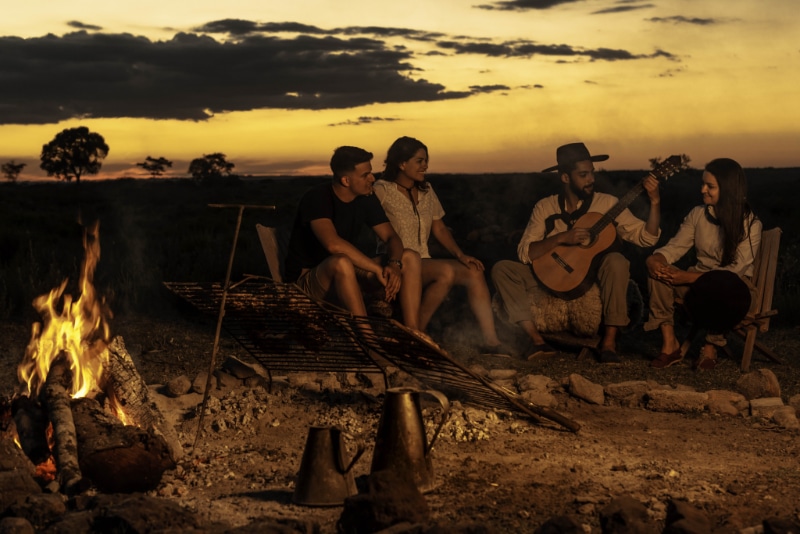
Music
The land of candombe, murga and tango, Uruguay is synonymous with musical fusion and the birthplace of hundreds of internationally renowned musicians.
Musical creation has a very long history which, in the case of candombe, can be traced back to the 18th century, although, as pointed out in the Primer Catálogo de Música Uruguaya, historian and musicologist Lauro Ayestarán has also managed to trace the indigenous origins of Uruguayan musical production.
The country’s history in general and its musical culture in particular are marked by European immigration, which arrived in successive waves between the second half of the 19th century and the 1950s.The majority of immigrants were Spanish (Galicians, Basques, Catalans and Canaries), closely followed by Italians and a significant number of French, Germans, Armenians, Portuguese, British, Swiss, Russians and Poles, among others. This melting pot of cultures was reflected in the music and, from these influences, typical styles of these lands were developed, such as candombe, tango, milonga, murga and a diversity of musical fusions that are produced, heard and make up the richness of Uruguay’s musical offer.
We invite you to download the Music of Uruguay Vol. 2 Catalog, which details the work of 140 contemporary national artists of relevance in activity, divided into several genres: candombe; classical/contemporary; electronic/hip hop; children’s; jazz fusion; popular/songwriter’s song; popular/murga and murga song; folkloric roots; rock/pop, tango and Uruguayan tropical.
-
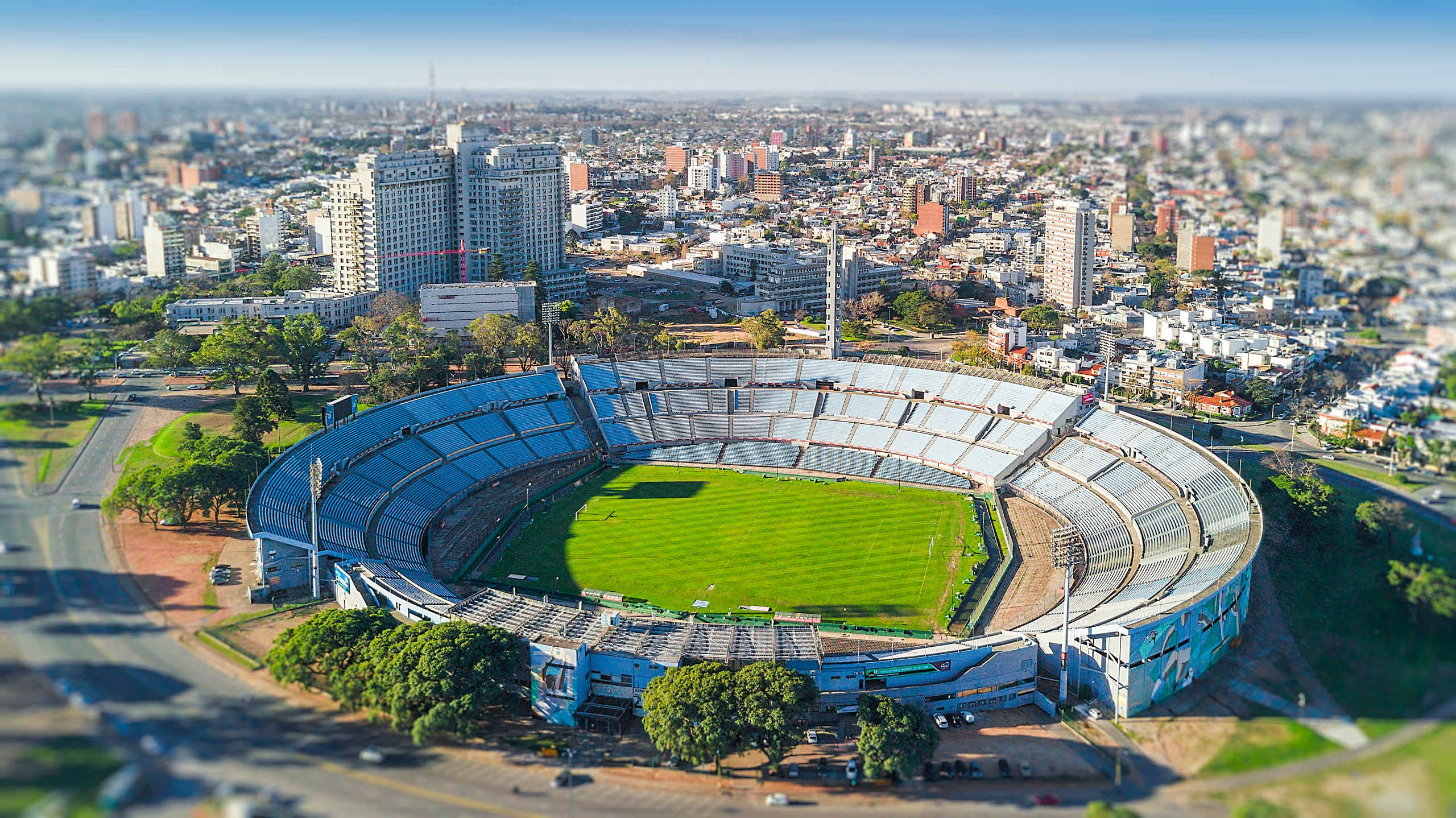
Soccer
Soccer is the passion of our people. For Uruguay, due to its own dimensions, every international sporting triumph is almost an achievement. Throughout its history it has occupied Olympic podiums in cycling, boxing, basketball, soccer and rowing. It has also done so in other disciplines in continental competitions. However, success and passion have given soccer a significance greater than the sport itself. Soccer is watched, but above all it is played.
It is common for Uruguayans to point out that the country has the same number of technical directors as inhabitants. This expresses the extent to which soccer represents us. It is probable that each world championship or the Olympic championships won a long time ago have contributed to our sense of nationhood. The similes of soccer terms are used by the whole society, even in official acts.
Soccer is the passion of our people. For Uruguay, due to its own dimensions, every international sporting triumph is almost an achievement. Throughout its history it has occupied Olympic podiums in cycling, boxing, basketball, soccer and rowing. It has also done so in other disciplines in continental competitions. However, success and passion have given soccer a significance greater than that of the sport itself.
Soccer can be watched, but above all, it is played. It is common for Uruguayans to point out that the country has the same number of technical directors as inhabitants. This expresses to what extent soccer represents us. It is likely that each world championship or the Olympic championships won a long time ago have contributed to our sense of nationhood. The similes of soccer terms are used by the whole society, even in official acts.
Since its beginnings, the national team achieved glory. The titles obtained in the 1924 and 1928 Olympics, and the 1930 and 1950 World Championships, were great moments that marked the vast history of Uruguayan soccer. In addition, to this must be added the club conquests of Peñarol and Nacional, the two most popular teams in our league. Sports lovers should not miss a visit to the Football Museum, where an infinite number of objects recall the sky-blue exploits of all times.
Links of interest
-
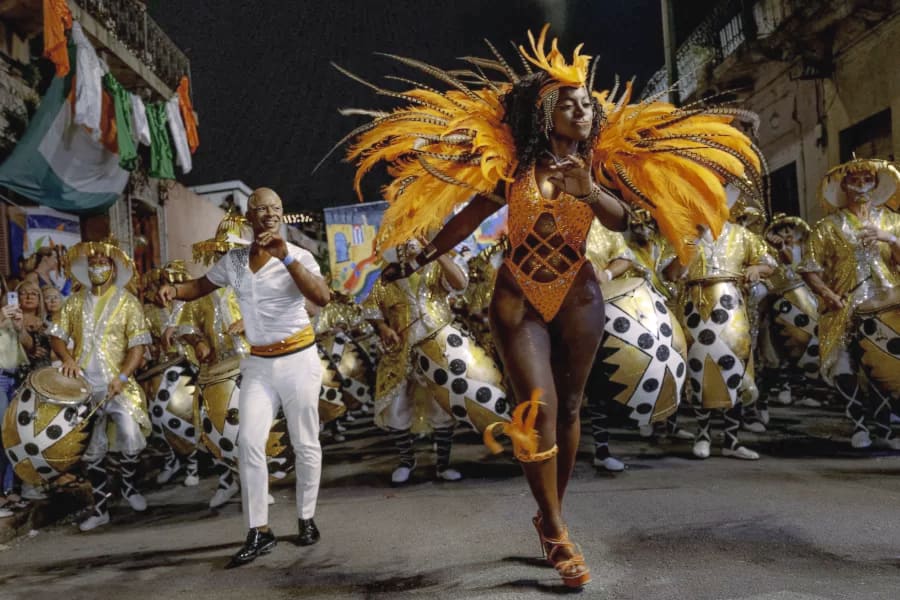
Carnival
Uruguay’s carnival is the longest in the world. It starts at the end of January and lasts until mid-March. For more than 50 days, colorful and joyful shows are presented in street parades and on neighborhood stages.
The kick-off in Montevideo is the Inaugural Parade on Avenida 18 de Julio, in which all the groups involved in the festivities take part, accompanied by floats and the parade of Carnival Queens. However, the parade that arouses the most interest among foreigners, due to its uniqueness, is the LLamadas Parade, which takes place in the southern and Palermo neighborhoods, evoking the gatherings of black slaves who met outside the city during the 18th and 19th centuries.
Tens of thousands of spectators vibrate with the power and color of candombe, characterized by the dialogue of three types of drums: chico, repique and piano. The spectacle is thrilling; nowhere else in the world can you hear more than 2,000 drums beating in unison. Getting carried away by this rhythm, declared a World Heritage Site, is a must for visitors. So is discovering the murga, one of the most genuine expressions of Uruguayan culture due to its popular support. On warm February nights, these carnival groups perform on neighborhood stages, the “tablados”, and compete in the Official Carnival Contest, where they present their vision of the country and the world with humor and satire, using various choral arrangements, flashy costumes and creative makeup.
Parodistas, Revistas, Humoristas and Lubolos are some of the other colorful expressions that can be enjoyed at the contest and on the stages of Montevideo. Beyond Montevideo, all the cities of the interior of the country have their own inaugural parade, each one with its own particularities. Thus, in the border towns, such as Rivera, Artigas and Melo, the parades adopt more elements of the Brazilian carnival.
-
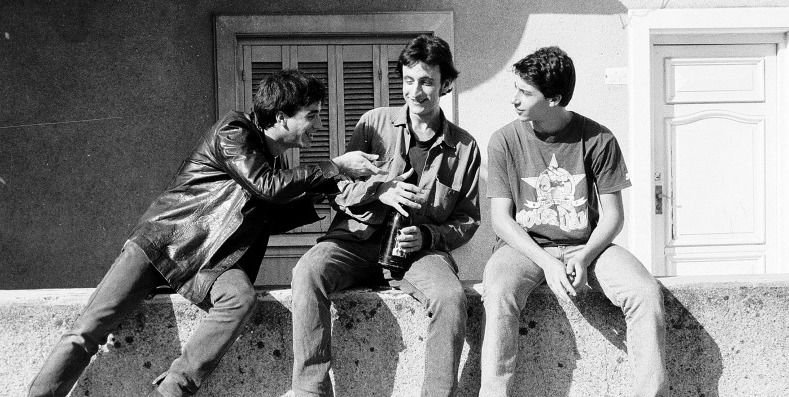
Film
In the last 25 years, Uruguayan cinema has reached an extraordinary level with films such as Whisky and El baño del Papa, which have won awards at festivals around the world.
In the last 25 years, Uruguayan cinema has reached an extraordinary level with films such as Whisky and El baño del Papa, which have won awards at festivals around the world.
Uruguayan cinema has more than a century of history. Although Louis Lumière’s invention arrived in the country early – as early as 1898 the country had its first documentary film, Carrera de bicicletas en el velódromo de Arroyo Seco by Félix Oliver – the first hundred years were marked by scarce resources and intermittent projects.
However, in the last 25 years, Uruguayan cinema has reached an extraordinary level, both in terms of national productions that stand out in the most diverse festivals around the world and the production services offered in the country to foreign productions in areas such as advertising, documentaries and feature films.
The feature film 25 Watts (2001) was a great boost to the self-esteem of national cinema after receiving 10 international awards, including Best Film at the International Film Festival Rotterdam and Best First Film at the Havana Film Festival. Every year since then, Uruguayan films have won awards at film festivals around the world.
An interesting reading for those who want to learn about the evolution of Uruguayan film production in recent decades are the catalogs prepared by the Uruguay Film Commission & Promotion Office, which summarizes the main productions in both Fiction and Documentary. There is also one specifically dedicated to the promotion of Uruguay’s excellent filming locations. -
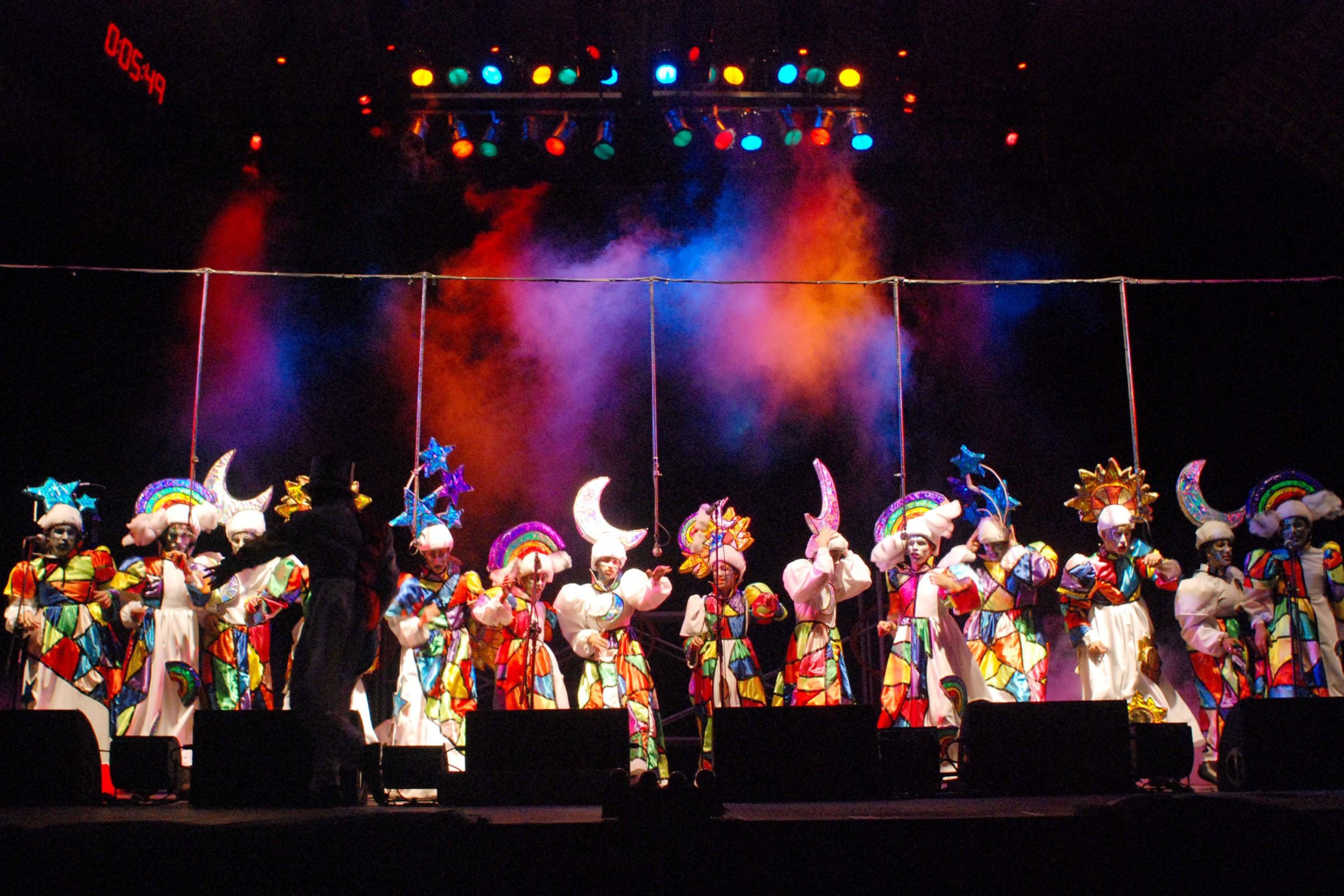
Murga
The Uruguayan murga is unique and, in recent decades, it has become a cultural manifestation that gathers followers all over the world.
The murga is one of the greatest expressions of Uruguayan culture due to its popular support. Although one of its origins is identified as Cádiz (especially since 1908), it has undergone numerous transformations since the end of the 19th century.
The murgas have always featured a wide variety of musical rhythms, including the “marcha camión”, in which the percussive rhythms of candombe are identified. In terms of costumes and make-up, there are links with other European artistic expressions.
The Uruguayan murga is currently made up of 17 members: a stage and choir director, 13 members of the choir or “cuerda de voces”, divided according to the tone of voice, and 3 members who make up the “batería”, made up of cymbals, bass drum and redoblante.
In recent decades, their integration has been mixed. The so-called “young murgas” have revitalized staging and stage movement, just as in other times there were murgas that marked the innovations in the shows of each historical moment.
The performances of the “murgas”, which tour public and private stages, both in Montevideo and in the interior of the country, bring to the stage lyrics with humor, satire and criticism of current events, making use of multiple choral arrangements, striking costumes and creative make-up.
Carnival is born in the neighborhoods and most of them have a murga to encourage, support or accompany, either in the parades or in the official competitions, which have qualifying juries that award prizes and mentions.
Rehearsals are open to the public, allowing entire families to memorize and sing their repertoires. It is undoubtedly one of the most popular expressions of culture.
In Montevideo, you can visit the Carnival Museum all year round. It displays the memory of this festival, part of national history. Thousands of visitors who have come to the country outside the carnival season have been able to capture the allure of the Uruguayan carnival in its halls, and have decided to come to enjoy it and share it with the carnivalesques as hosts. -
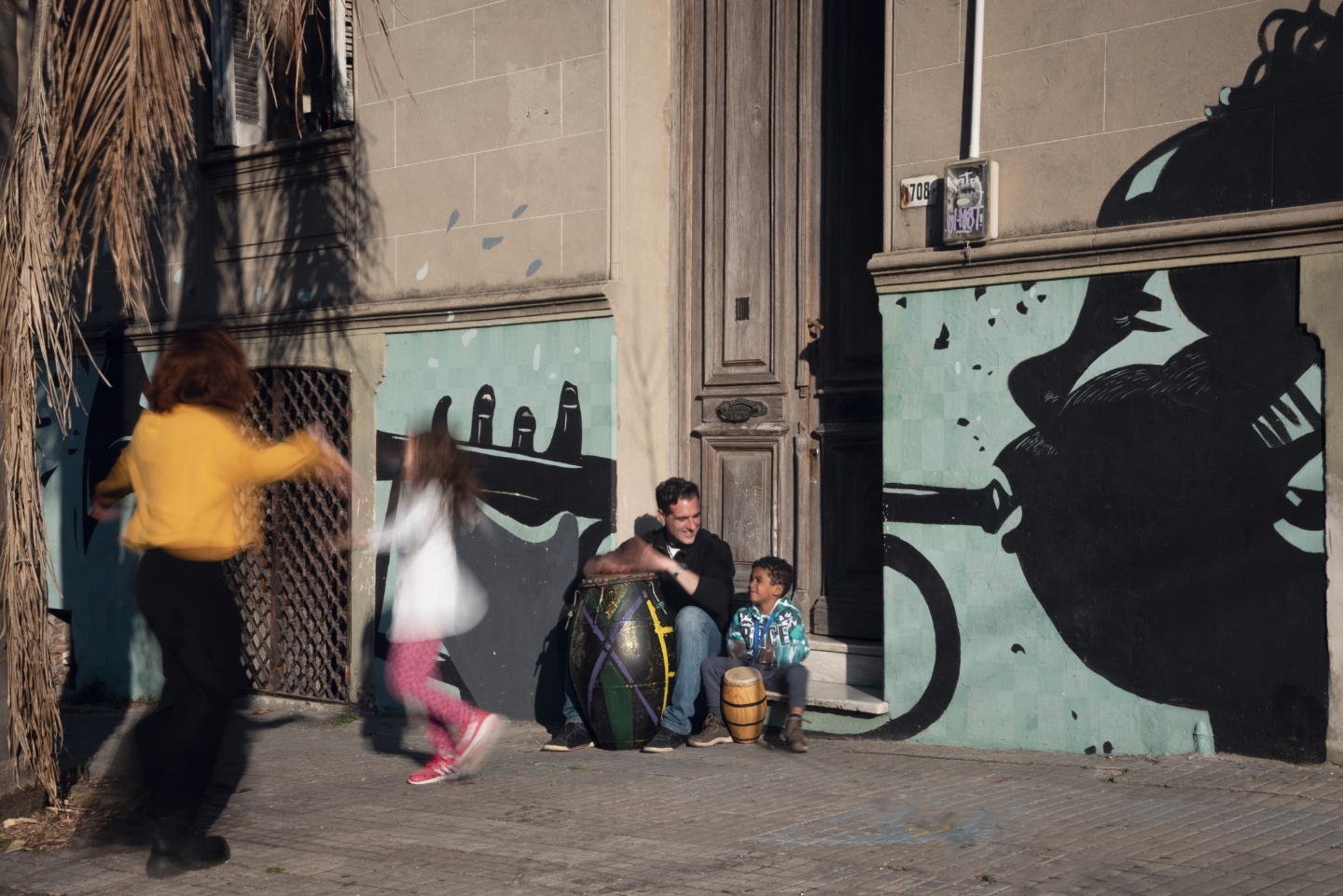
Candombe
Recognized as Intangible Heritage of Humanity, the candome seduces visitors with the peculiar sound of its three drums: chico, repique and piano. In the Parade of Llamadas, more than 2,000 drums sound in unison along the route. This can not be enjoyed at any other time or place in the world.
Recognized as Intangible Heritage of Humanity, the candome seduces visitors with the peculiar sound of its three drums: chico, repique and piano. In the Parade of Llamadas, more than 2,000 drums sound in unison along the route. This can not be enjoyed at any other time or place in the world.

The Societies of Negros and Lubolos or Comparsas de Candombe, are heirs of a tradition rooted in the so-called “Salas de Nación” of the Colonial era. The Africans brought as slaves managed to transmit inheritances and values of their rich culture and in that process gave birth to the “tambor”.
The drums constitute the essence of the comparsa. The rhythm of Candombe comes from the so-called cuerda, a group formed by three types of drums: piano, repique and chico. The tambor is played by hitting the lonja with the open hand and with a stick that can also beat on the wood; it is hung from a shoulder by means of a strap in order to be able to march while playing.
In front of the string of drums, whose number can exceed seventy performers, the rest of the comparsa is deployed with their typical costumes.
The Llamadas parade takes its name from “the call of the drum”, which the Afro-descendants used to gather “outside the walls” and since the late nineteenth century in some collective dwellings called conventillos, in neighborhoods or areas of Montevideo.
The march of each group opens with a banner, symbolizing the emblem of the Tribe or Ethnic Group, other significant elements are crescents and stars, to which giant flags are added.
Then the dance troupe and the ancestral characters are placed. The Gramillero represents the sorcerer of the tribe; he is dressed in a frock coat, top hat, cane, glasses and white beard and carries a suitcase with herbs with healing properties. He is accompanied by the Mama Vieja, in colorful attire, with fan and parasol, who dances slowly flirting with the Gramillero. The Escobero originally guided the drums during the parade with a cane; today he dances with a small broom, giving movement following the rhythm of the drums. Striking vedettes add sensuality to these dances, evoking rituals, dancing in front of the rope.




